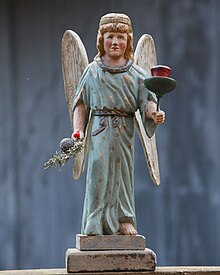Angel of lights
Angel lights and light miners are figures made of wood by artisans or in the arts and crafts , mostly from the Ore Mountains and almost always colored, that carry one or two candles and are set up during Advent and Christmas. As a rule, they are products of the Erzgebirge folk art and are created by wood turning or as individual pieces by wood carving . Often they are seen as symbols of the Christmas customs in the Ore Mountains.
Forerunner of today's angel of lights
In the 16th century, kneeling, light-bearing angel figures were created for the Lorenz Church in Nuremberg ( Veit Stoss ) but were not widely used.
The early light angels were floating angels in the form of a youth in a long tunic (still without wings), based on ancient and Hellenistic representations of genius and on models in Jewish art. In the late Middle Ages the tunic became a dress, and the youth took on girlish features and wore a ribbon or a hoop in his hair. Many of these floating angels carry a cornucopia or a flower basket. The wings were added at this time. From the baroque era , when the nativity scene was created, depictions of angels as a winged toddler clad only with a loin band (presumably derived from a putti ). Life -size figures were allowed to float down from the ceiling for the Mettenspiel in the church.
Today, floating angels are occasionally made according to old specifications. Some old specimens can be seen in the Manufactory of Dreams in Annaberg-Buchholz .
Stand angel as light bearer
Carved standing angel lights are not very common. Turned angels are hardly detectable before 1830. With the development of wood turning and the introduction of the cheaper stearin and paraffin candles (after 1860), the light carriers could be manufactured and illuminated more cheaply in larger numbers. The oldest surviving specimens come from the Schneeberg in the 19th century. After turning the body ("Dockendrehn"), the angels were given arms, hands and feet made of plastic material by hand and were painted. Later arms, hands and feet were cut or turned from wood and sometimes carved. The figures made using plastic material for arms and hands, usually referred to as so-called dough arms, are rare exceptions today that only a few artisans have in their program.
The Nuremberg Kronendocke (rattle doll for small children) and pictures of the Nuremberg Rauschgoldengel from 1790 could have been the inspiration for the design. The fashionable angel of the 18th century was very slender around the middle and equipped with a high, barrel-shaped crown and a scarf crossed on the chest. In the middle of the 19th century, the tight waists were given a wide, pleated upper dress.
Schneeberger figures usually carried a bow with three candles and were often white with dark red patterned underdress and colored edges. In Oberwiesenthal a golden serrated crown was preferred, the angels wore a light on the right, the left hand supports a wreath with twelve candles that rests on the crown of the head. By putting on feet, these angels work even longer.
The " Seiffen angels", which are still common today , are based on the female profile of the time, the angels often wear an apron (symbolizes the housewife, the "angel in the house"). Gold leaf on the wings, which were cut from boards, reflects the candlelight and provides more brightness. The angel's crown, formerly with prongs or arches, became a simple cylinder - so more angels could be turned with less effort. Turning as a craft occupation particularly prevailed around Seiffen and Grünhainichen. Many different forms of light carriers were created here, including the “bell angel” and “bell miner” from the workshop of Friedrich Wilhelm Füchtner .
A special feature are the rarer leg angels, called Baa angels in the Erzgebirge , in which the skirt does not reach the base on which they stand, but the feet and part of the leg can be seen. The production is more complex, since the whole hull cannot be made in one piece by wood turning, but the lower part of the body has to be turned or cut separately and, in some models, also has to be carved.
Nowadays there are light carriers in all shapes and sizes, for candle operation or with electric lights.
gallery
- Carved angel figures from the Western Ore Mountains
See also
literature
- Regina Krippner: The Museum for Mining Folk Art Schneeberg. Retrieved July 12, 2016 (PDF, 361 kB).
Web links
Individual evidence
- ↑ Lößnitzengel ( Memento of the original from March 4, 2016 in the Internet Archive ) Info: The archive link was inserted automatically and has not yet been checked. Please check the original and archive link according to the instructions and then remove this notice. on the website of the Dresden State Art Collection.
- ^ Gisela Bellmann, Hans-Jürgen Irmscher: Light miner and light angel in the Saxon Ore Mountains. Husum, Husum 1998, ISBN 3-88042-863-8 , p. 6 ff.
- ↑ Bell angel on the website of the Staatliche Museen Berlin.
- ^ Gerhard Kaufmann (Ed.): Erzgebirge. The longing for the light. Toys and handicrafts from the Martin Collection in the Altona Museum. Catalog, Hamburg 1992, p. 49, p. 53, p. 56.













